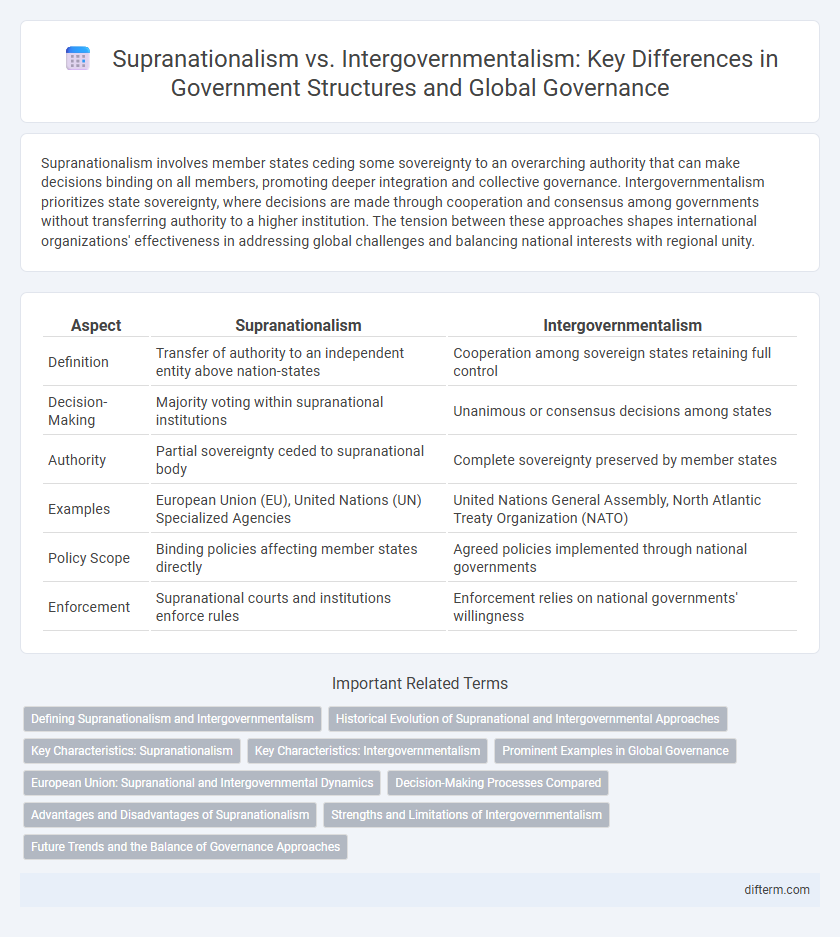Supranationalism involves member states ceding some sovereignty to an overarching authority that can make decisions binding on all members, promoting deeper integration and collective governance. Intergovernmentalism prioritizes state sovereignty, where decisions are made through cooperation and consensus among governments without transferring authority to a higher institution. The tension between these approaches shapes international organizations' effectiveness in addressing global challenges and balancing national interests with regional unity.
Table of Comparison
| Aspect | Supranationalism | Intergovernmentalism |
|---|---|---|
| Definition | Transfer of authority to an independent entity above nation-states | Cooperation among sovereign states retaining full control |
| Decision-Making | Majority voting within supranational institutions | Unanimous or consensus decisions among states |
| Authority | Partial sovereignty ceded to supranational body | Complete sovereignty preserved by member states |
| Examples | European Union (EU), United Nations (UN) Specialized Agencies | United Nations General Assembly, North Atlantic Treaty Organization (NATO) |
| Policy Scope | Binding policies affecting member states directly | Agreed policies implemented through national governments |
| Enforcement | Supranational courts and institutions enforce rules | Enforcement relies on national governments' willingness |
Defining Supranationalism and Intergovernmentalism
Supranationalism refers to a form of multinational cooperation where sovereign states delegate authority to an overarching organization with legal and political powers, enabling decisions to be made that are binding on member states. Intergovernmentalism emphasizes collaboration between sovereign governments that retain full control over decision-making processes, requiring consensus or unanimous agreement before actions are taken. The key distinction lies in the degree of authority ceded to supranational entities versus the preservation of state sovereignty within intergovernmental frameworks.
Historical Evolution of Supranational and Intergovernmental Approaches
The historical evolution of supranationalism and intergovernmentalism reveals key milestones such as the Treaty of Rome in 1957, which established the European Economic Community as a pioneering supranational organization. Intergovernmentalism gained prominence post-World War II with institutions like the United Nations emphasizing state sovereignty in decision-making. The ongoing tension between pooled sovereignty in supranational bodies and retained authority in intergovernmental frameworks shapes contemporary governance models globally.
Key Characteristics: Supranationalism
Supranationalism involves the transfer of authority from individual governments to an overarching entity with independent powers, enabling decision-making that binds member states. Key characteristics include centralized institutions like the European Commission and the European Court of Justice, which can enforce regulations directly on member states and individuals. This governance model emphasizes pooling sovereignty and promoting collective action beyond national interests.
Key Characteristics: Intergovernmentalism
Intergovernmentalism emphasizes cooperation among sovereign states that retain ultimate authority over decisions, with power centralized in national governments rather than supranational institutions. Key characteristics include unanimous decision-making, state sovereignty preservation, and limited delegation of authority to international organizations. This approach contrasts with supranationalism by prioritizing national interests and inter-state negotiations over pooled sovereignty.
Prominent Examples in Global Governance
The European Union exemplifies supranationalism by delegating significant authority to centralized institutions like the European Commission and European Court of Justice, enabling collective decision-making beyond individual states. In contrast, the United Nations demonstrates intergovernmentalism, where member states retain sovereignty and cooperate through consensus without surrendering authority to a higher governing body. Organizations such as NATO also reflect intergovernmentalism, emphasizing coordination and cooperation among sovereign states rather than supranational governance.
European Union: Supranational and Intergovernmental Dynamics
The European Union exemplifies a hybrid model where supranational institutions like the European Commission and European Court of Justice wield authority independent of member states, enabling unified policy implementation across areas such as trade, competition, and environmental standards. Concurrently, intergovernmental mechanisms manifest through the European Council and Council of the European Union, where member states retain sovereignty by negotiating and making decisions collectively on sensitive issues like foreign policy and fiscal matters. This dual structure balances pooled sovereignty with national autonomy, fostering integration while respecting member state interests and enabling flexible cooperation within the EU framework.
Decision-Making Processes Compared
Supranationalism centralizes decision-making authority in institutions above the national level, enabling binding decisions that member states must comply with, often exemplified by the European Union's Commission and Court of Justice. Intergovernmentalism emphasizes decision-making through consensus among sovereign states, preserving national veto power and prioritizing state sovereignty, as seen in the United Nations Security Council. These contrasting processes influence policy integration, with supranationalism promoting deeper cooperation and intergovernmentalism ensuring state control over outcomes.
Advantages and Disadvantages of Supranationalism
Supranationalism enhances cooperation by enabling member states to make collective decisions through delegated authority, which can lead to more effective policy implementation across borders, such as in the European Union's regulatory frameworks. The centralization of power promotes uniform standards and stronger enforcement mechanisms but may reduce national sovereignty, causing resistance from states reluctant to cede control over critical issues like immigration or defense. Despite its ability to foster integration and economic stability, supranationalism risks bureaucratic inefficiency and democratic deficits due to decision-making sometimes occurring beyond direct voter influence.
Strengths and Limitations of Intergovernmentalism
Intergovernmentalism emphasizes state sovereignty, allowing national governments to retain control over decision-making processes and prioritize their own interests, ensuring a flexible approach to cooperation that respects diverse political and economic contexts. Its strength lies in fostering consensus among member states, which can enhance legitimacy and stability in international collaborations. However, the limitation is that it may lead to slow decision-making due to the need for unanimity, and the potential for national interests to block collective action, reducing the effectiveness of supranational governance.
Future Trends and the Balance of Governance Approaches
Future trends in governance reveal a shifting balance between supranationalism, which promotes deeper integration and centralized authority within entities like the European Union, and intergovernmentalism, emphasizing state sovereignty and cooperation through negotiation. Technological advancements and global challenges such as climate change and pandemics accelerate supranational mechanisms to enforce unified policies, while rising nationalism and geopolitical tensions bolster intergovernmental approaches prioritizing national interests. The evolving governance landscape requires adaptive frameworks blending supranational coordination with intergovernmental autonomy to address complex transnational issues effectively.
Supranationalism vs Intergovernmentalism Infographic

 difterm.com
difterm.com